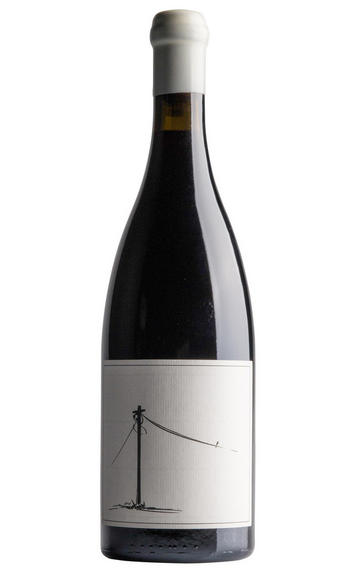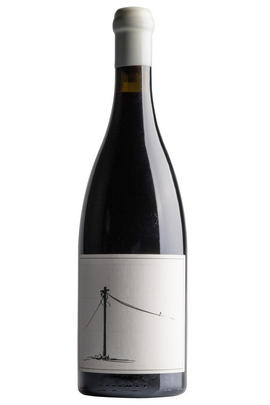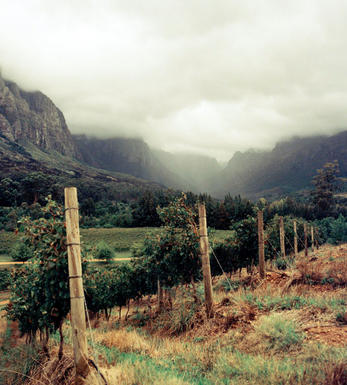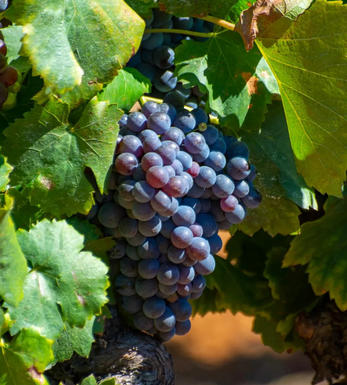
2022 Savage, Follow the Line, Western Cape, South Africa

Critics reviews
The 2022 Follow the Line contains 50% whole clusters with two weeks on the skins, aged in foudre for ten months. It has a winsome nose with brambly red berry fruit, briar, lavender and rose petals bursting with aeration. The palate is well structured (Savage mentioning there is a touch more on the mid-palate) and grippy, with just a bit of muscle towards the slightly closed finish, suggesting that it will benefit from 12 months in bottle. Excellent.
I dropped in to see winemaker Duncan Savage at his Cape Town winery, where he proudly showed me the top floor above the winery he recently acquired, freeing up a lot more space.
“It was quite warm as a vintage,” he tells me. “The 2022s were picked at similar levels to normal, but there was more selection and sorting. We picked 11 tons between 40 people, and 12 people had to sort them carefully because of bird damage. The acids are slightly lower than usual. We meddle only where we need to meddle. Chenin Blanc can get rich and flabby; we must manage that. So, barrels are stored at around 10° Celsius rather than 16° Celsius to keep the whites as tight as possible.”
This was a brilliant set of distinct wines from Savage, crowned by a stunning Touriga Naçional/Syrah blend under the “Are We There Yet?” moniker. The Savage Red, which utilises 40% whole clusters, is one of the best released yet, and I feel it’s superior to the white counterpartit’s year.
Drink 2025 - 2040
Neal Martin, Vinous.com (November 2023)
92% Cinsault, 8% Syrah. 12 months in foudres, amphorae and 500-litre barrels.
Mellow garnet colour. Not much nose but a promise of savour underneath. Very juicy fruit and not a trace of Cape toughness. It's really quite complete with some length.
Drink 2023 - 2029
Jancis Robinson MW, JancisRobinson.com (October 2023)
This is a supple and delicious red showing aromas of paprika, wild herbs, strawberries and red cherries on the nose. Very soft tannins that melt in your mouth. Medium-bodied, fresh and fruit-driven.
Drink now or hold
James Suckling, JamesSuckling.com (November 2023)
Coastal coolness thrums through this Darling Cinsault, from a 1982 block. Wild flowers, bramblewood, rose perfume, and woody incense weave in with white pepper spice. A slightly warmer vintage than previous, as well as 8% Syrah, adds more flesh to its elegantly sculpted bones, tucked in by paper-fine tannins. 50% whole bunch, complexity is further encouraged by a mix of ageing vessels: older 500-litre barrels, foudre and amphorae for a year before bottling.
Drink 2024 - 2029
Malu Lambert, Decanter.com (September 2023)
About this WINE

Savage
After 11 years producing Platter five-star wines at Cape Point Vineyards, Duncan Savage finally realised his dream of producing his own red and white wine before the age of 35 with his maiden (2011 red, 2012 white) vintage. The wines received high critical acclaim (four and a half stars each from Platter) with Duncan once again in the spotlight as one of the most exciting young talents in South African winemaking. The wines are made with the blessing of Cape Point where he still works as winemaker and viticulturalist.
Duncan’s aim is to produce elegant wines which reflect their terroir and he does this by using fruit from old vines with whole bunch fermentation, minimal intervention and use of old wood, and also amphorae for the Savage Red. Duncan says that the key is to “do as little as possible, as much as you can.” These are exciting new wines to watch on the South African scene, both of them capable of long ageing. Again, availability is limited.

Western Cape
The Western Cape wine region in South Africa is one of the country's most prominent and renowned wine-producing areas. It encompasses a variety of distinct wine regions, each with its terroir, grape varietals, and winemaking traditions. Some well-known wine regions within the Western Cape include Stellenbosch, Franschhoek, Paarl, Constantia, Hemel-en-Aarde Valley, and Swartland.
Stellenbosch, often called the heart of South African wine, is renowned for its historic vineyards, picturesque landscapes, and award-winning wines. It produces a wide range of grape varietals, with Cabernet Sauvignon, Chenin Blanc, and Syrah particularly notable.
Franschhoek, known as the "French Corner" due to its Huguenot heritage, offers a scenic setting surrounded by mountains. This region is recognised for its world-class sparkling wines, Chardonnay and Semillon.
Paarl is known for its diverse terroir, producing rich, full-bodied red wines such as Shiraz and Pinotage. It is also home to historic estates and has a warm Mediterranean climate.
Constantia, located near Cape Town, is one of the oldest wine regions in South Africa. It is famous for its elegant and sought-after white wines, particularly the sweet dessert wine called Vin de Constance.
Hemel-en-Aarde Valley, situated close to the coastal town of Hermanus, is known for its cool climate and specialises in producing exceptional cool-climate varietals like Pinot Noir and Chardonnay.
Swartland, located north of Cape Town, has gained recognition for its innovative winemaking and for producing unique and expressive wines from traditional and alternative grape varieties.
The Western Cape wine region benefits from diverse soils, varied microclimates, and proximity to the ocean, creating favourable conditions for grape cultivation. South African winemakers in the Western Cape often combine traditional winemaking practices with modern techniques, resulting in wines that reflect the region's distinct characteristics and balance New and Old World influences.

Cinsault
Cinsault (pronounced "sin-so") is a red grape variety known for its versatility and contributions to various wine regions worldwide. It has a rich history, primarily in the Languedoc region of southern France, but it has spread to many other wine-producing areas due to its adaptability to different climates.
Cinsault grapes are medium-sized with thin skins, typically dark blue to black in colour. The vines are hardy and drought-resistant grapevine, making them suitable for warm and arid climates. They are particularly well-suited to Mediterranean regions and thrive in areas with hot summers.
While Cinsault is mainly used in red wine production, it is also sometimes used in rosé wines, adding light and fruity character. It is often blended with other grape varieties to enhance the wine profile.
The variety tends to exhibit a range of flavours, including red berries, cherries, and sometimes a hint of spices. When used in rosé wines, it can bring out more floral and watermelon notes.
Tannins are typically on the lower side, which can make them more approachable and enjoyable in their youth. The variety is often used in blends to soften and round out more tannic grape varieties.
Cinsault has been a key component in traditional blends in southern France, such as in Châteauneuf-du-Pape wines. Over time, it has gained popularity in other wine regions as winemakers recognize its potential for producing high-quality wines.


Buying options
Add to wishlist
Description
The 2022 Follow the Line contains 50% whole clusters with two weeks on the skins, aged in foudre for ten months. It has a winsome nose with brambly red berry fruit, briar, lavender and rose petals bursting with aeration. The palate is well structured (Savage mentioning there is a touch more on the mid-palate) and grippy, with just a bit of muscle towards the slightly closed finish, suggesting that it will benefit from 12 months in bottle. Excellent.
I dropped in to see winemaker Duncan Savage at his Cape Town winery, where he proudly showed me the top floor above the winery he recently acquired, freeing up a lot more space.
“It was quite warm as a vintage,” he tells me. “The 2022s were picked at similar levels to normal, but there was more selection and sorting. We picked 11 tons between 40 people, and 12 people had to sort them carefully because of bird damage. The acids are slightly lower than usual. We meddle only where we need to meddle. Chenin Blanc can get rich and flabby; we must manage that. So, barrels are stored at around 10° Celsius rather than 16° Celsius to keep the whites as tight as possible.”
This was a brilliant set of distinct wines from Savage, crowned by a stunning Touriga Naçional/Syrah blend under the “Are We There Yet?” moniker. The Savage Red, which utilises 40% whole clusters, is one of the best released yet, and I feel it’s superior to the white counterpartit’s year.
Drink 2025 - 2040
Neal Martin, Vinous.com (November 2023)
wine at a glance
Delivery and quality guarantee